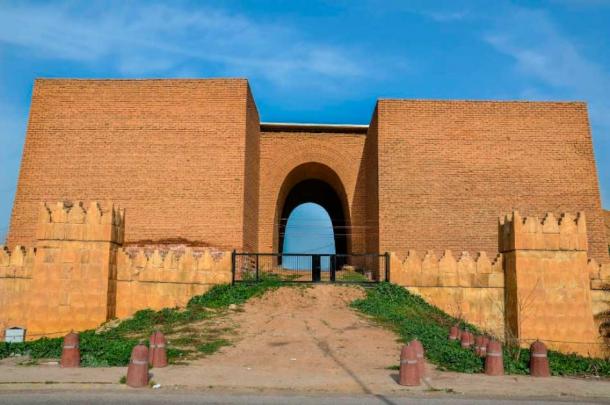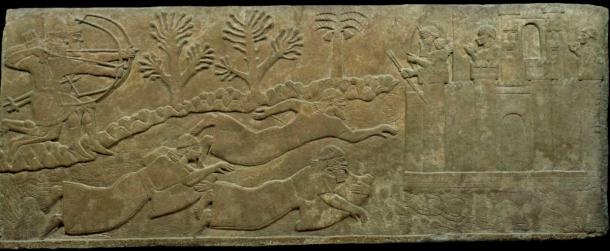
Ancient Assyrian Carvings Found Near Mashki Gate Destroyed by ISIS
Eight stunningly detailed carved stone panels have been discovered near the Mosul, Iraq. They were unearthed near Mashki Gate, a site that was bulldozed by Islamic State (IS) terrorists in 2016.
The Iraqi State Board of Antiquities and Heritage recently told AFP that the ancient stone carved panels date back to the King Sennacherib, who ruled the ancient Assyrian city of Nineveh from 705 to 681 BC.
Destruction and Restoration of Historical Treasures
King Sennacherib, Akkadian Sin-akhkheeriba, was the son of Sargon II. After a string of legendary military wins in the region, Sennacherib made Nineveh his capital city and famously expanded the settlement. He built a grand new palace and erected thick inner and outer city walls that still stand today.
BBC reports that the carvings were found by a US-Iraqi excavation team while they were reconstructing the ancient Mashki Gate. The gate was previously reconstructed in the 1970s, but it was destroyed with a bulldozer by IS militants in 2016. Eight magnificent marble reliefs have been recovered, which show “finely chiseled war scenes, grape vines, and palm trees.” When the restoration project is complete, these new reliefs will be a part of a new educational center dedicated to the history of Nineveh.
- 3000-Year-Old Assyrian Reliefs Unearthed in ISIS Stomping Ground
- Shock Find! Assyrian Palace from 600 BC Discovered Under Demolished Shrine in Iraq

A 2014 photo of Mashki Gate, one of fifteen gates to ancient Nineveh. The gate was destroyed by IS in 2016. (Mohamed albaroodi91 / CC BY SA 4.0)
The restoration project at the Mashki Gate is being conducted by archaeologists from Iraq's Mosul University and the United States' University of Pennsylvania. Dr. Fadel Mohammed Khodr, head of the Iraqi archaeological team, told AFP that the carved stone relics once adorned the king's palace and that they were later moved to the Mashki Gate. He added that they were “partly buried,” and that the sections that were underground were preserved, while whatever was above ground “was wiped smooth over the centuries.”
- Nineveh: Exploring the Ruins of the Crown City of Ancient Assyria
- Assyrian Palace Discovered in Terrorists’ Treasure Tunnels

A separate Assyrian wall panel relief from the same period as those unearthed near Mashki Gate, 875BC-860BC. It displays similar styles and features to the recently discovered reliefs. (British Museum / CC BY-NC-SA 4.0)
Stone Symbology: The Deadly Arrow and the Sacred Tree
Among the most important, or revelatory, carvings discovered depicts an Assyrian soldier pulling a bow string to fire an arrow. This particular carving offers deep insight into an important aspect of Assyrian warfare, and one that helped them to maintain their power for so many decades from the Persian Gulf to the Mediterranean Sea. According to Archery Historian, ancient Assyrian armies were “the greatest the world had ever seen” and this was largely due to the strength of their archers.
Archers were the main component of the Assyrian infantry. History books record many sieges against Assyrian cities where the armies defended their city walls with long-range arrow fire. The craft of bow shooting was so highly respected that kings were often depicted wielding the weapon. It’s even possible that one of the archers depicted on the recently recovered carved panels might also be a king.
Beside the archer, the ancient artisans depicted grape vines and a palm, the latter of which was a sacred plant for Assyrian kings. The Brooklyn Museum houses twelve carved stone slabs from the Northwest Palace of Ashurnasirpal II. The motif of the so-called “sacred tree” appears on seven of the twelve slabs. According to the 2014 paper Assyrian Sacred Trees in the Brooklyn Museum, the Palm Date “is evidently a sacred symbol, is elaborately and tastefully formed.” This study concluded that the intended image might be “a stylized palm tree, a cult object, an emblem of vegetation or ‘tree of life’, an imperial symbol, or a combination of those forms.”
Thus, in the carved archer, the grape, and the palm, we have a salvaged story of both war and peace. While the Assyrian archer represents dark and violent times, the grape and the palm signify peace, safe harvests and abundance. When the whole site is fully restored, there will no doubt be similar stories told by the stone panels - and the new educational center will feature them all.
Top Image: These ancient Iraq carvings dating to the Assyrian Empire were unearthed near the Mashki Gate in Mosul, escaping destruction by IS in 2016. Source: Iraqi Ministry of Culture
By Ashley Cowie
References
Albenda, P. August 7, 2014. Assyrian Sacred Trees in the Brooklyn Museum. Cambridge University Press. Available at: https://www.cambridge.org/core/journals/iraq/article/abs/assyrian-sacred-trees-in-the-brooklyn-museum/A16F208B9D4D7243C7C0C037A1FD8103
Assyrian Archers. n.d. Archery Historian. Available at: https://archeryhistorian.com/assyrian-archers/
The Mashki Gate Restoration, Mosul. n.d. Culture in Crisis. Available at: https://cultureincrisis.org/projects/the-mashki-gate-restoration-mosul
Wertheimer, T. October 19, 2022. Mashki Gate: Stunning ancient rock carvings found in Iraq. BBC. Available at: https://www.bbc.com/news/world-middle-east-63323825
















Comments
Ill provide another possibility.. think.. isis and the mossad actually have the same acronym(Israeli secret intelligence service) isis has never actually attacked israel.. operation northwoods... The mossad is often credited as being the "best" intelligence organization in the world.. so maybe
. Just maybe.. the whole "isis" concept was created by the mossad for whatever reason... this would explain a lot of unanswered questions..
infinitesimal waveparticles comprise what we call home the earth
manipulatable by thought ability supressed in humans since birth
Thank you, yet again, Mr Wagner.
Well, we should first assume the reported ‘bulldozing’ (and btw who provided the bulldozers?) was not meant to destroy relics, but to destroy evidence of theft and looting of marketable relics. As always, need to FOLLOW THE MONEY!
Nobody gets paid to tell the truth.